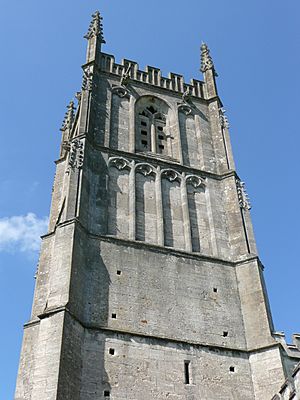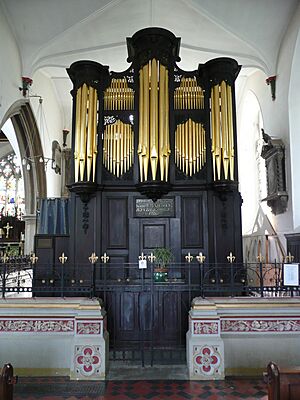St Mary the Virgin, Wotton-under-Edge facts for kids
Quick facts for kids St Mary the Virgin, Wotton-under-Edge |
|
|---|---|

St Mary the Virgin, Wotton-under-Edge
|
|
| 51°38′20.5″N 2°20′53″W / 51.639028°N 2.34806°W | |
| Denomination | Church of England |
| Churchmanship | Broad Church |
| History | |
| Dedication | St Mary |
| Administration | |
| Parish | Wotton-under-Edge |
| Diocese | Gloucester |
| Province | Canterbury |
St Mary the Virgin Church in Wotton-under-Edge is a very old and important building. It was officially opened on August 19, 1283, by Bishop Godfrey Giffard. Most of the church you see today was finished by 1325. This was about 171 years after its first known vicar, Gerinus, was recorded in 1154. It is one of four churches in the town of Wotton-under-Edge in Gloucestershire, England.
Exploring St Mary's Church
Inside the Church: Special Areas
Let's take a look at some of the interesting parts inside St Mary's Church. Each area has its own history and purpose.
The Sacristy: A Place for Preparation
The sacristy was built in the 1830s. It holds special boards that list charities, which used to be in other parts of the church. This room is where the acolytes (helpers) and minister get ready for services. It also stores items used during church events.
The Sanctuary: A Holy Space
The roof over the sanctuary is very old. It is the only part left from the 16th-century roof that once covered the main area of the church. The reredos, a decorated screen behind the altar, is newer. It is made from English Oak and designed to look like it belongs with the church's old style. It was made to remember Charlotte Sewell.
The East Window in the sanctuary is from 1325, when the church was completed. It shows angels and saints worshiping Christ.
The Brasses: Ancient Tombs
Near the sacristy, you can find the tombs of Lord Thomas IV and Lady Berkeley. Lord Thomas was a brave admiral who fought in the famous Battle of Agincourt. The brass decorations on their tombs are from 1392. They are the second oldest brasses in all of Gloucestershire.
The Chancel and Choir: Music and Light
The choir stalls, where the choir sits, were added to the church in 1885. A beautiful chandelier hangs above them. This chandelier was a gift from William Moore in 1763. It is only lit for very special events.
The Catherine Chapel: A Quiet Corner
The Catharine Chapel is located at the top of the north aisle. It is named after St Catherine. This chapel was first built in medieval times, perhaps soon after the main church. It was made larger in 1780 and then restored as a chapel in 1928. Today, it is used for morning prayer on Fridays.
The Tower: A Tall Landmark
The church tower stands at the west end of the church. It was built in six main parts. The first two parts were built around 1320, when the church was first constructed. The other four parts were added later but were finished by the end of the 14th century. The tower is very tall, reaching 47 meters (about 154 feet) high.
The Clock: Keeping Time for the Town
The clock on the tower was built in 1902. It is about halfway up the west side of the tower. The clock face is six feet wide, and its hands and numbers are made from brass.
The Bells: A Ringing History
The bells were first made in 1756 in Gloucester. In 1902, when the tower was being fixed up (and the clock was added), the bells were hung on strong steel frames. They were rehung again in 1960. The bells ring out in the musical key of E-flat.
The Amazing Organ
St Mary's Church is very well known for its large organ. It is located in the south-east part of the church, next to the altar. This organ is one of the biggest in the county. It is famous because Georg Handel, a very famous composer, once played it. He played it when the organ was in its previous home at St Martin in the Fields church.
The organ was given to St Martin in the Fields by King George I. It has many different sounds, called stops, and can be played using three keyboards (manuals) and a pedalboard. These stops include two trumpets, six diapasons, a cornopean, and a flute.
You can find more details about this organ on the National Pipe Organ Register.


